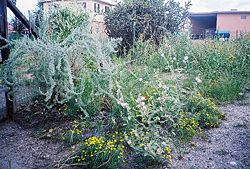Xeriscape: Difference between revisions
imported>Mary Ash (Starting Xeriscape page) |
mNo edit summary |
||
| (3 intermediate revisions by one other user not shown) | |||
| Line 1: | Line 1: | ||
{{subpages}} | {{subpages}} | ||
{{TOC|right}} | |||
{{Image|800px-Xeriscape3.jpg|right|250px|New Mexico Xeriscape landscape and garden.}} | |||
== History == | == History == | ||
The term Xeriscape was created by the Denver Water Department in 1981 to help promote water wise gardening. The name Xeriscape is trademarked by the DWD. <ref name="Denver Water">{{cite web |url=http://www.denverwater.org/Conservation/Xeriscape/ |title=Xeriscape |accessdate=2010-10-02}}</ref> | The term Xeriscape was created by the Denver Water Department in 1981 to help promote water wise gardening. The name Xeriscape is trademarked by the DWD. <ref name="Denver Water">{{cite web |url=http://www.denverwater.org/Conservation/Xeriscape/ |title=Xeriscape |accessdate=2010-10-02}}</ref> | ||
| Line 19: | Line 22: | ||
{{reflist}} | {{reflist}} | ||
[[Category:Suggestion Bot Tag]] | |||
Latest revision as of 17:00, 9 November 2024
History
The term Xeriscape was created by the Denver Water Department in 1981 to help promote water wise gardening. The name Xeriscape is trademarked by the DWD. [1] [2]
Implementation
Xeriscaping uses environmentally appropriate plants to help maximize natural resources. Gardeners use a zonal approach to gardening called hydrozoning. The zones are broken down into:
Oasis zones are usually close to the house to benefit from rain runoff or the protection of shade.
Transition zones combine drier areas with those needing low or moderate moisture.
Arid zones would be farthest from the house and in low-traffic areas; often these areas are natural habitat or planted with native or drought-tolerant specimens. [2]
Drainage and Mulch
Other considerations when planning a Xeriscape garden include drainage and mulch.
- ↑ Xeriscape. Retrieved on 2010-10-02.
- ↑ 2.0 2.1 Garden Styles: Xeriscape. Retrieved on 2010-10-02.
